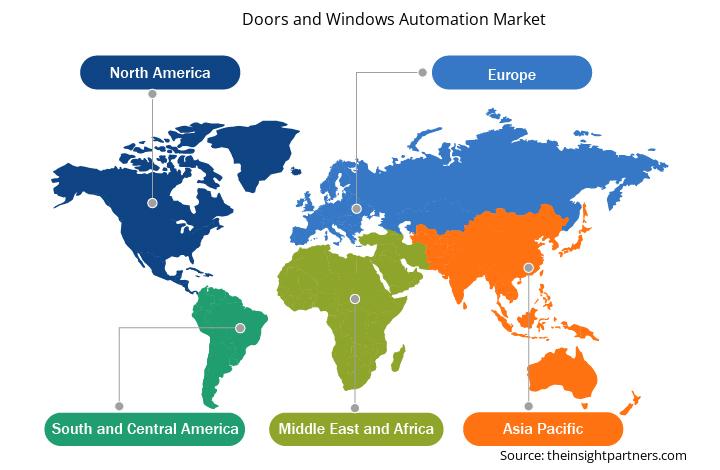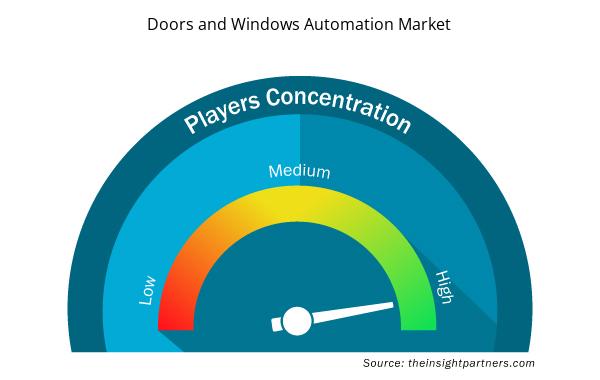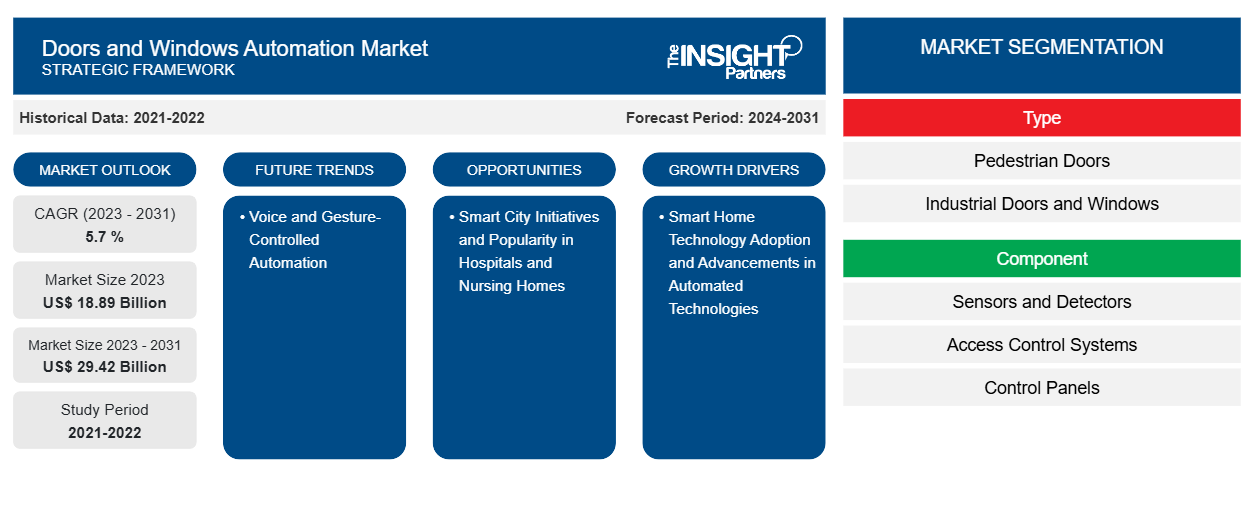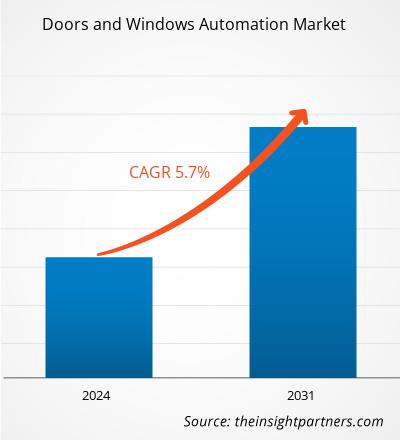Der Markt für Tür- und Fensterautomatisierung wird voraussichtlich von 18,89 Milliarden US-Dollar im Jahr 2023 auf 29,42 Milliarden US-Dollar im Jahr 2031 anwachsen. Der Markt wird zwischen 2023 und 2031 voraussichtlich eine durchschnittliche jährliche Wachstumsrate von 5,7 % verzeichnen. Sprach- und gestengesteuerte Automatisierung wird in den kommenden Jahren wahrscheinlich neue Trends auf den Markt für Tür- und Fensterautomatisierung bringen.
Marktanalyse für die Automatisierung von Türen und Fenstern
Faktoren wie die Einführung von Smart-Home-Technologien und Fortschritte bei Automatisierungstechnologien treiben den Markt für Tür- und Fensterautomatisierung an . Aufgrund zunehmender Smart-City-Initiativen und der steigenden Beliebtheit automatisierter Systeme in Krankenhäusern und Pflegeheimen wird erwartet, dass der Markt im Prognosezeitraum wächst. Die Nachfrage nach Tür- und Fensterautomatisierungslösungen wird von mehreren Schlüsselfaktoren getrieben, darunter der steigenden Nachfrage nach Komfort, Sicherheit und Energieeffizienz in Wohn- und Geschäftsgebäuden. Technologische Fortschritte wie die Integration von Smart-Home-Systemen, Sprach- und Gestensteuerung und Bewegungssensoren verbessern das Benutzererlebnis und ermöglichen eine nahtlose Automatisierung. Der zunehmende Fokus auf Nachhaltigkeit trägt ebenfalls zum Marktwachstum bei, da automatisierte Türen und Fenster die Belüftung optimieren und den Energieverbrauch senken, was zu Kosteneinsparungen führt. Darüber hinaus hat das wachsende Bewusstsein für Hygiene, insbesondere im Gesundheitswesen und in gewerblichen Einrichtungen, die Einführung berührungsloser Automatisierungssysteme beschleunigt. Diese Faktoren sowie die Urbanisierung und eine wachsende Präferenz für intelligente, vernetzte Häuser treiben die Expansion des Marktes voran.
Marktübersicht zur Tür- und Fensterautomatisierung
Unter Tür- und Fensterautomatisierung versteht man die Integration fortschrittlicher Technologien, die den automatischen Betrieb von Türen und Fenstern ermöglichen und so Komfort, Sicherheit, Energieeffizienz und Zugänglichkeit verbessern. Diese Automatisierung kann durch Sensoren, Motoren und Steuerungssysteme erreicht werden, die das Öffnen oder Schließen von Türen und Fenstern je nach bestimmten Bedingungen oder Benutzerbefehlen ermöglichen. Zu den gängigen Funktionen gehören berührungslose, sprachaktivierte oder gestengesteuerte Bedienung sowie die intelligente Integration mit Hausautomationssystemen für eine nahtlose Steuerung über Plattformen wie Amazon Alexa oder Google Assistant. Diese automatisierten Systeme werden zunehmend sowohl in Wohn- als auch in Geschäftsgebäuden eingesetzt und bieten Vorteile wie erhöhte Sicherheit, Energieeinsparungen durch optimierte Belüftung und verbesserte Hygiene durch Reduzierung des physischen Kontakts mit Oberflächen.
Passen Sie diesen Bericht Ihren Anforderungen an
Sie erhalten kostenlos individuelle Anpassungen an jedem Bericht, einschließlich Teilen dieses Berichts oder einer Analyse auf Länderebene, eines Excel-Datenpakets sowie tolle Angebote und Rabatte für Start-ups und Universitäten.
- Holen Sie sich die wichtigsten Markttrends aus diesem Bericht.Dieses KOSTENLOSE Beispiel umfasst eine Datenanalyse von Markttrends bis hin zu Schätzungen und Prognosen.
Markttreiber und Chancen für die Tür- und Fensterautomatisierung
Einführung von Smart-Home-Technologie
Smart Homes integrieren Tür- und Fensterautomatisierungssysteme, da Hausbesitzer mehr Komfort, Energieeffizienz und Sicherheit wünschen. Als Teil des breiteren Trends der Smart-Home-Technologien und der zunehmenden Verfügbarkeit vernetzter Geräte integrieren Verbraucher zunehmend automatisierte Systeme in ihre Häuser, um das tägliche Wohnerlebnis zu verbessern und den Energieverbrauch zu senken. Unternehmen wie Marvin, Somfy, WindowMaster und View Glass bieten fortschrittliche Lösungen, die automatisierte Türen und Fenster mit Smart Homes verbinden. So kündigte Somfy, der weltweit führende Hersteller von Motoren für Innenfensterabdeckungen und Außensonnenschutz, im September 2023 seine Integration und Zertifizierung mit Apple Home an. Diese Zertifizierung ermöglicht eine nahtlose Kompatibilität zwischen den von Somfy unterstützten Zigbee-Motoren, die in Innenfensteranwendungen verwendet werden, und dem TaHoma-Schalter mit Apple Home. Die Zigbee 3.0-Technologie, eine weltweit eingesetzte und sichere IoT-Lösung, erleichtert die Interoperabilität, indem sie Smart-Home-Geräte mit einem einheitlichen Netzwerk verbindet, sodass die Produkte reibungslos funktionieren. Die neue Integration bietet eine einfache und sichere Möglichkeit, motorisierte Fensterabdeckungen mit Zigbee-Motoren von Somfy über die Apple Home-App und Siri auf Geräten wie iPhone, iPad, Apple Watch, HomePod und Mac zu steuern. Die Einführung von Smart-Home-Technologie treibt somit den Markt für Tür- und Fensterautomatisierung voran.
Smart City-Initiativen
Städte werden technologisch immer fortschrittlicher und vernetzter, was zu einer wachsenden Nachfrage nach automatisierter Infrastruktur führt, die den Gebäudebetrieb optimieren, die Sicherheit erhöhen und die Energieeffizienz verbessern kann. Laut dem Entwicklungsprogramm der Vereinten Nationen leben mehr als 60 % der Weltbevölkerung in Städten, davon mehr als 70 % der Erwerbstätigen; außerdem werden 80 % des weltweiten wirtschaftlichen Werts in Städten erwirtschaftet. Regierungen verschiedener Länder ergreifen Initiativen für Smart Cities, die sich darauf konzentrieren, das Internet zu nutzen, um Informationen auszutauschen, die Betriebseffizienz zu verbessern und den in Smart Cities lebenden Bürgern eine bessere Servicequalität zu bieten. So gibt es beispielsweise laut dem Ministerium für Stadtentwicklung insgesamt 8.033 (Smart Cities Mission)-Projekte in 100 Städten Indiens, von denen 7.038 (88 %) bereits abgeschlossen und 995 (12 %) laufende Projekte sind. Ebenso kündigte die chinesische Regierung im Jahr 2023 ihren Plan an, mehr als 500 Smart Cities zu bauen. Im Juli 2023 finanzierte die Regierung ein Projekt im Wert von 200 Millionen US-Dollar zur Entwicklung der Phase 1 des Guangzhou Smart City-Projekts. Smart City-Initiativen beinhalten die Einführung verschiedener intelligenter Technologien, darunter Tür- und Fensterautomatisierungssysteme, die den Betrieb energieeffizienter und nachhaltiger machen und den Kohlenstoffausstoß minimieren. Auch in Dubai werden mehrere Geschäftsgebäude mit automatisierten Türen und Fenstern ausgestattet, als Teil der Vision der Stadt, eine der weltweit führenden Smart Cities zu werden, und unterstützen die Integration intelligenter Technologien für Nachhaltigkeit und Komfort. Darüber hinaus ist Dubai weiterhin führend in der Entwicklung von Smart Cities, mit Projekten wie der Dubai Silicon Oasis, die automatisierte Türen und Fenster integrieren, um die Energieeffizienz in Geschäfts- und Wohngebäuden zu optimieren. Diese Systeme sind so konzipiert, dass sie sich automatisch an die Wetterbedingungen anpassen und so zur Energieeinsparung und zum Ziel der Stadt beitragen, den Kohlenstoffausstoß zu reduzieren. Daher wird erwartet, dass die steigende Zahl von Initiativen in Smart City -Projekten im Prognosezeitraum verschiedene Möglichkeiten für das Marktwachstum schaffen wird.
Segmentierungsanalyse des Marktberichts zur Automatisierung von Türen und Fenstern
Wichtige Segmente, die zur Ableitung der Marktanalyse für die Tür- und Fensterautomatisierung beigetragen haben, sind Typ, Komponente, Steuerungssystem und Branche.
- Basierend auf dem Typ wird der Markt für Tür- und Fensterautomatisierung in Fenster, Industrietüren und Fußgängertüren unterteilt. Das Segment Fußgängertüren dominierte den Markt im Jahr 2023.
- In Bezug auf die Komponenten ist der Markt für Tür- und Fensterautomatisierung in Zugangskontrollsysteme, Bedienfelder, Sensoren und Detektoren, Motoren und Aktuatoren und andere unterteilt. Das Segment Sensoren und Detektoren hatte im Jahr 2023 den größten Marktanteil.
- Nach Steuerungssystem ist der Markt für Tür- und Fensterautomatisierung in vollautomatische, halbautomatische und Servosysteme unterteilt. Das vollautomatische Segment dominierte den Markt im Jahr 2023.
- Basierend auf der Branchenvertikale wird der Markt für Tür- und Fensterautomatisierung in Wohn-, Gewerbe- und Industriebereiche unterteilt. Das gewerbliche Segment hatte im Jahr 2023 den größten Anteil am Markt für Tür- und Fensterautomatisierung.
Marktanteilsanalyse für die Tür- und Fensterautomatisierung nach geografischen Gesichtspunkten
Der Markt für Tür- und Fensterautomatisierung ist in fünf große Regionen unterteilt: Nordamerika, Europa, Asien-Pazifik (APAC), Naher Osten und Afrika (MEA) sowie Süd- und Mittelamerika. Nordamerika dominierte den Markt im Jahr 2023, gefolgt von Europa und APAC.
Der Markt für Tür- und Fensterautomatisierung in Nordamerika ist in die USA, Kanada und Mexiko unterteilt. In bedeutenden Ländern Nordamerikas ist ein deutlicher Anstieg von Smart Homes und Smart City-Programmen zu verzeichnen. Die Regierungen verschiedener Länder in der Region fördern die Einführung von Smart Cities, was voraussichtlich die Wohn- und Gewerbebautätigkeit ankurbeln und die Nachfrage nach automatisierten Türen und Fenstern steigern wird. Die Integration von Automatisierungstechnologie in Tür- und Fenstersysteme hilft beim Energiesparen, da sie dazu beiträgt, Türen und Fenster für einen optimalen Zeitraum ver- oder entriegelt zu halten.
Regionale Einblicke in den Markt für Tür- und Fensterautomatisierung
Die regionalen Trends und Faktoren, die den Markt für Tür- und Fensterautomatisierung während des gesamten Prognosezeitraums beeinflussen, wurden von den Analysten von Insight Partners ausführlich erläutert. In diesem Abschnitt werden auch die Marktsegmente und die Geografie der Tür- und Fensterautomatisierung in Nordamerika, Europa, im asiatisch-pazifischen Raum, im Nahen Osten und Afrika sowie in Süd- und Mittelamerika erörtert.

- Erhalten Sie regionale Daten zum Markt für Tür- und Fensterautomatisierung
Umfang des Marktberichts zur Automatisierung von Türen und Fenstern
| Berichtsattribut | Details |
|---|---|
| Marktgröße im Jahr 2023 | 18,89 Milliarden US-Dollar |
| Marktgröße bis 2031 | 29,42 Milliarden US-Dollar |
| Globale CAGR (2023 - 2031) | 5,7 % |
| Historische Daten | 2021-2022 |
| Prognosezeitraum | 2024–2031 |
| Abgedeckte Segmente | Nach Typ
|
| Abgedeckte Regionen und Länder | Nordamerika
|
| Marktführer und wichtige Unternehmensprofile |
|
Dichte der Marktteilnehmer für die Automatisierung von Türen und Fenstern: Verständnis ihrer Auswirkungen auf die Geschäftsdynamik
Der Markt für Tür- und Fensterautomatisierung wächst rasant. Dies wird durch die steigende Nachfrage der Endnutzer aufgrund von Faktoren wie sich entwickelnden Verbraucherpräferenzen, technologischen Fortschritten und einem größeren Bewusstsein für die Vorteile des Produkts vorangetrieben. Mit der steigenden Nachfrage erweitern Unternehmen ihr Angebot, entwickeln Innovationen, um die Bedürfnisse der Verbraucher zu erfüllen, und nutzen neue Trends, was das Marktwachstum weiter ankurbelt.
Die Marktteilnehmerdichte bezieht sich auf die Verteilung der Firmen oder Unternehmen, die in einem bestimmten Markt oder einer bestimmten Branche tätig sind. Sie gibt an, wie viele Wettbewerber (Marktteilnehmer) in einem bestimmten Marktraum im Verhältnis zu seiner Größe oder seinem gesamten Marktwert präsent sind.
Die wichtigsten Unternehmen auf dem Markt für Tür- und Fensterautomatisierung sind:
- ABB Ltd
- Allegion Plc
- Assa Abloy AB
- Came SpA
- Honeywell International Inc
- Insteon
Haftungsausschluss : Die oben aufgeführten Unternehmen sind nicht in einer bestimmten Reihenfolge aufgeführt.

- Überblick über die wichtigsten Akteure auf dem Markt für Tür- und Fensterautomatisierung
Marktnachrichten und aktuelle Entwicklungen zur Automatisierung von Türen und Fenstern
Der Markt für Tür- und Fensterautomatisierung wird durch die Erhebung qualitativer und quantitativer Daten nach Primär- und Sekundärforschung bewertet, die wichtige Unternehmensveröffentlichungen, Verbandsdaten und Datenbanken umfasst. Nachfolgend sind einige der wichtigsten Entwicklungen auf dem Markt für Tür- und Fensterautomatisierung aufgeführt:
- Allegion plc hat über eine seiner Tochtergesellschaften SOSS Door Hardware (SOSS) übernommen. Als führender Hersteller hochwertiger Scharniere und Türbeschläge verkauft SOSS seine Lösungen hauptsächlich auf nordamerikanischen Nichtwohnmärkten. Die Lösungen von SOSS ergänzen die Türbeschläge der Marken Ives, Glynn-Johnson und Zero International des Unternehmens und ermöglichen es dem Unternehmen, seinen Kunden ein breiteres Portfolio anzubieten und diesen Kernbereich des Geschäfts letztlich auszubauen.
(Quelle: Allegion plc, Pressemitteilung, Oktober 2024)
- ABB hat auf der diesjährigen Messe Light + Building in Frankfurt Upgrades für sein Portfolio an ABB-Welcome-Türsprechanlagen vorgestellt. Die Versionen der nächsten Generation von ABB-Welcome und ABB-Welcome IP wurden mit weiterentwickeltem Design, vereinfachter Systemarchitektur und verbesserter Konnektivität eingeführt. ABB-Welcome bietet eine vielseitige 2-Draht-Lösung für die Türkommunikation mit einer breiten Palette modularer Designs. Es umfasst eine vollständige Palette von Außen- und Innenstationen. Hauseingangsbereiche, einschließlich Tore und Haus- oder Eingangstüren, können bequem mit Mobiltelefonen verbunden werden, um schneller auf Anrufe an der Tür reagieren zu können; außerdem kann der Zugang per Fernzugriff über eine App gewährt werden.
(Quelle: ABB, Pressemitteilung, März 2024)
Marktbericht zur Automatisierung von Türen und Fenstern – Umfang und Ergebnisse
Die „Marktgröße und Prognose für die Automatisierung von Türen und Fenstern (2021–2031)“ bietet eine detaillierte Analyse des Marktes, die die unten genannten Bereiche abdeckt:
- Marktgröße und Prognose für die Automatisierung von Türen und Fenstern auf globaler, regionaler und Länderebene für alle wichtigen Marktsegmente, die im Rahmen des Berichts abgedeckt sind
- Markttrends und Marktdynamiken für die Automatisierung von Türen und Fenstern wie Treiber, Einschränkungen und wichtige Chancen
- Detaillierte PEST- und SWOT-Analyse
- Marktanalyse für die Automatisierung von Türen und Fenstern, die wichtige Markttrends, globale und regionale Rahmenbedingungen, wichtige Akteure, Vorschriften und aktuelle Marktentwicklungen umfasst
- Branchenlandschaft und Wettbewerbsanalyse, einschließlich Marktkonzentration, Heatmap-Analyse, prominenten Akteuren und aktuellen Entwicklungen auf dem Markt für Tür- und Fensterautomatisierung
- Detaillierte Firmenprofile
- Historische Analyse (2 Jahre), Basisjahr, Prognose (7 Jahre) mit CAGR
- PEST- und SWOT-Analyse
- Marktgröße Wert/Volumen – Global, Regional, Land
- Branche und Wettbewerbsumfeld
- Excel-Datensatz



Report Coverage
Revenue forecast, Company Analysis, Industry landscape, Growth factors, and Trends

Segment Covered
This text is related
to segments covered.

Regional Scope
North America, Europe, Asia Pacific, Middle East & Africa, South & Central America

Country Scope
This text is related
to country scope.
Häufig gestellte Fragen
Smart home technology adoption and advancements in automated technologies are driving the market growth.
The market is expected to reach a value of US$ 29.42 billion by 2031.
ASSA ABLOY, Schüco Deutschland, Allegion plc, Nabtesco Corporation, and Siemens AG are major players in the market.
Voice and gesture-controlled automation is key trends in the market.
The market is anticipated to expand at a CAGR of 5.7% during 2023-2031.
Trends and growth analysis reports related to Electronics and Semiconductor : READ MORE..
The List of Companies - Door and Window Automation Market
- ABB Ltd
- Allegion Plc
- Assa Abloy AB
- Came S.p.A.
- Honeywell International Inc
- Insteon
- Nabtesco Corp
- Schneider Electric SE
- Siemens AG
- GEZE GMBH
- dormakaba Holding AG
- Hormann Industries GmbH
- Kintrol Pty Ltd
- BEA (A Halma Company)
- JLC Group Ltd
- Deutschtec
- Auto Ingress Pty Ltd
- Ozone Overseas Pvt. Ltd.
- ERREKA
- Schüco International KG
The Insight Partners performs research in 4 major stages: Data Collection & Secondary Research, Primary Research, Data Analysis and Data Triangulation & Final Review.
- Data Collection and Secondary Research:
As a market research and consulting firm operating from a decade, we have published and advised several client across the globe. First step for any study will start with an assessment of currently available data and insights from existing reports. Further, historical and current market information is collected from Investor Presentations, Annual Reports, SEC Filings, etc., and other information related to company’s performance and market positioning are gathered from Paid Databases (Factiva, Hoovers, and Reuters) and various other publications available in public domain.
Several associations trade associates, technical forums, institutes, societies and organization are accessed to gain technical as well as market related insights through their publications such as research papers, blogs and press releases related to the studies are referred to get cues about the market. Further, white papers, journals, magazines, and other news articles published in last 3 years are scrutinized and analyzed to understand the current market trends.
- Primary Research:
The primarily interview analysis comprise of data obtained from industry participants interview and answers to survey questions gathered by in-house primary team.
For primary research, interviews are conducted with industry experts/CEOs/Marketing Managers/VPs/Subject Matter Experts from both demand and supply side to get a 360-degree view of the market. The primary team conducts several interviews based on the complexity of the markets to understand the various market trends and dynamics which makes research more credible and precise.
A typical research interview fulfils the following functions:
- Provides first-hand information on the market size, market trends, growth trends, competitive landscape, and outlook
- Validates and strengthens in-house secondary research findings
- Develops the analysis team’s expertise and market understanding
Primary research involves email interactions and telephone interviews for each market, category, segment, and sub-segment across geographies. The participants who typically take part in such a process include, but are not limited to:
- Industry participants: VPs, business development managers, market intelligence managers and national sales managers
- Outside experts: Valuation experts, research analysts and key opinion leaders specializing in the electronics and semiconductor industry.
Below is the breakup of our primary respondents by company, designation, and region:

Once we receive the confirmation from primary research sources or primary respondents, we finalize the base year market estimation and forecast the data as per the macroeconomic and microeconomic factors assessed during data collection.
- Data Analysis:
Once data is validated through both secondary as well as primary respondents, we finalize the market estimations by hypothesis formulation and factor analysis at regional and country level.
- Macro-Economic Factor Analysis:
We analyse macroeconomic indicators such the gross domestic product (GDP), increase in the demand for goods and services across industries, technological advancement, regional economic growth, governmental policies, the influence of COVID-19, PEST analysis, and other aspects. This analysis aids in setting benchmarks for various nations/regions and approximating market splits. Additionally, the general trend of the aforementioned components aid in determining the market's development possibilities.
- Country Level Data:
Various factors that are especially aligned to the country are taken into account to determine the market size for a certain area and country, including the presence of vendors, such as headquarters and offices, the country's GDP, demand patterns, and industry growth. To comprehend the market dynamics for the nation, a number of growth variables, inhibitors, application areas, and current market trends are researched. The aforementioned elements aid in determining the country's overall market's growth potential.
- Company Profile:
The “Table of Contents” is formulated by listing and analyzing more than 25 - 30 companies operating in the market ecosystem across geographies. However, we profile only 10 companies as a standard practice in our syndicate reports. These 10 companies comprise leading, emerging, and regional players. Nonetheless, our analysis is not restricted to the 10 listed companies, we also analyze other companies present in the market to develop a holistic view and understand the prevailing trends. The “Company Profiles” section in the report covers key facts, business description, products & services, financial information, SWOT analysis, and key developments. The financial information presented is extracted from the annual reports and official documents of the publicly listed companies. Upon collecting the information for the sections of respective companies, we verify them via various primary sources and then compile the data in respective company profiles. The company level information helps us in deriving the base number as well as in forecasting the market size.
- Developing Base Number:
Aggregation of sales statistics (2020-2022) and macro-economic factor, and other secondary and primary research insights are utilized to arrive at base number and related market shares for 2022. The data gaps are identified in this step and relevant market data is analyzed, collected from paid primary interviews or databases. On finalizing the base year market size, forecasts are developed on the basis of macro-economic, industry and market growth factors and company level analysis.
- Data Triangulation and Final Review:
The market findings and base year market size calculations are validated from supply as well as demand side. Demand side validations are based on macro-economic factor analysis and benchmarks for respective regions and countries. In case of supply side validations, revenues of major companies are estimated (in case not available) based on industry benchmark, approximate number of employees, product portfolio, and primary interviews revenues are gathered. Further revenue from target product/service segment is assessed to avoid overshooting of market statistics. In case of heavy deviations between supply and demand side values, all thes steps are repeated to achieve synchronization.
We follow an iterative model, wherein we share our research findings with Subject Matter Experts (SME’s) and Key Opinion Leaders (KOLs) until consensus view of the market is not formulated – this model negates any drastic deviation in the opinions of experts. Only validated and universally acceptable research findings are quoted in our reports.
We have important check points that we use to validate our research findings – which we call – data triangulation, where we validate the information, we generate from secondary sources with primary interviews and then we re-validate with our internal data bases and Subject matter experts. This comprehensive model enables us to deliver high quality, reliable data in shortest possible time.


 Holen Sie sich ein kostenloses Muster für diesen Bericht
Holen Sie sich ein kostenloses Muster für diesen Bericht